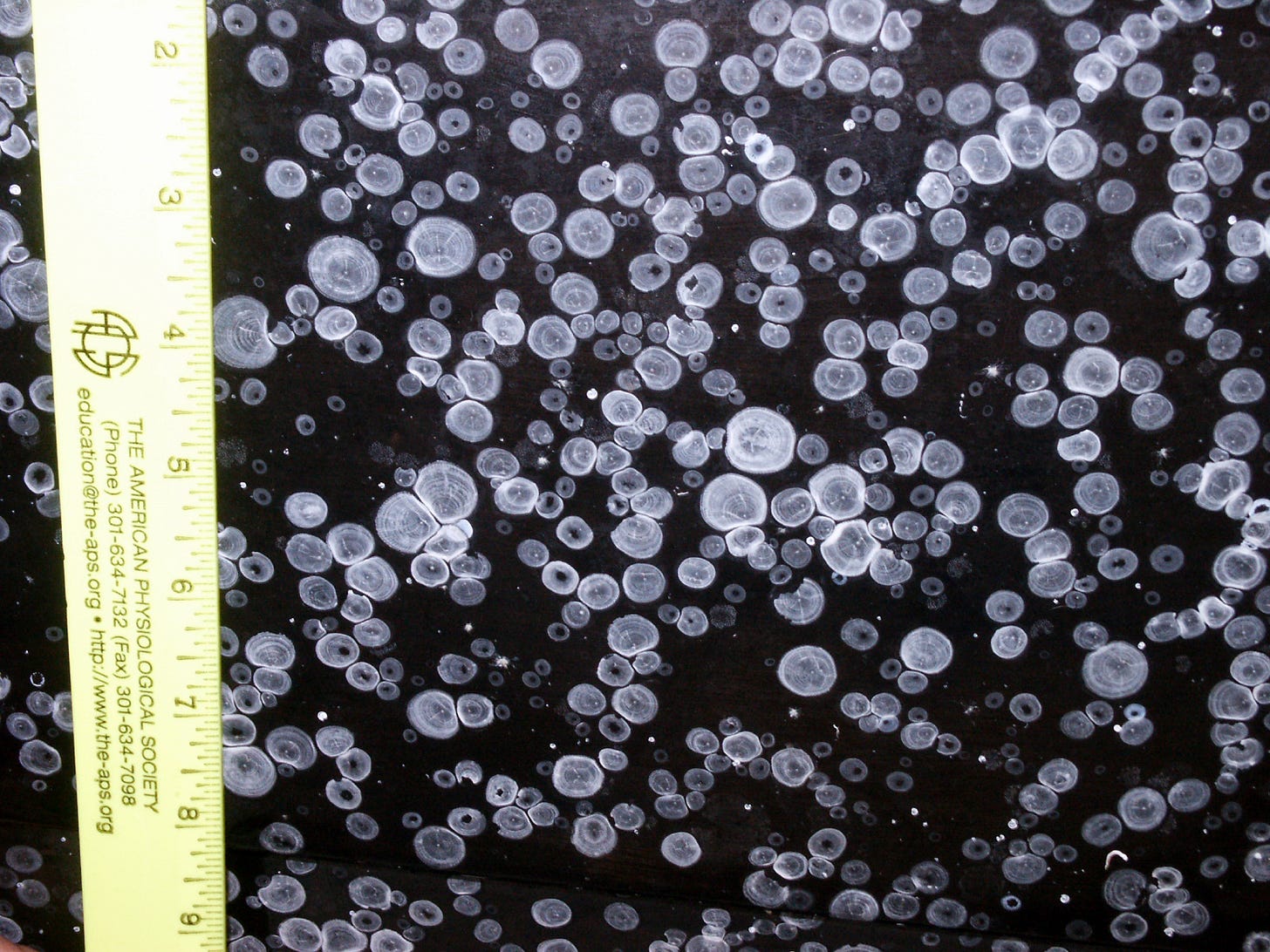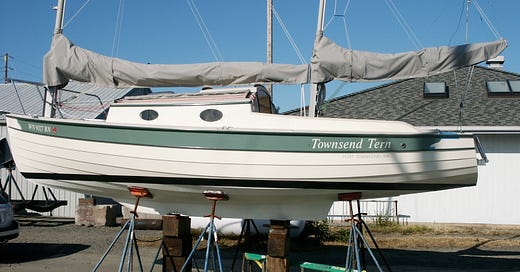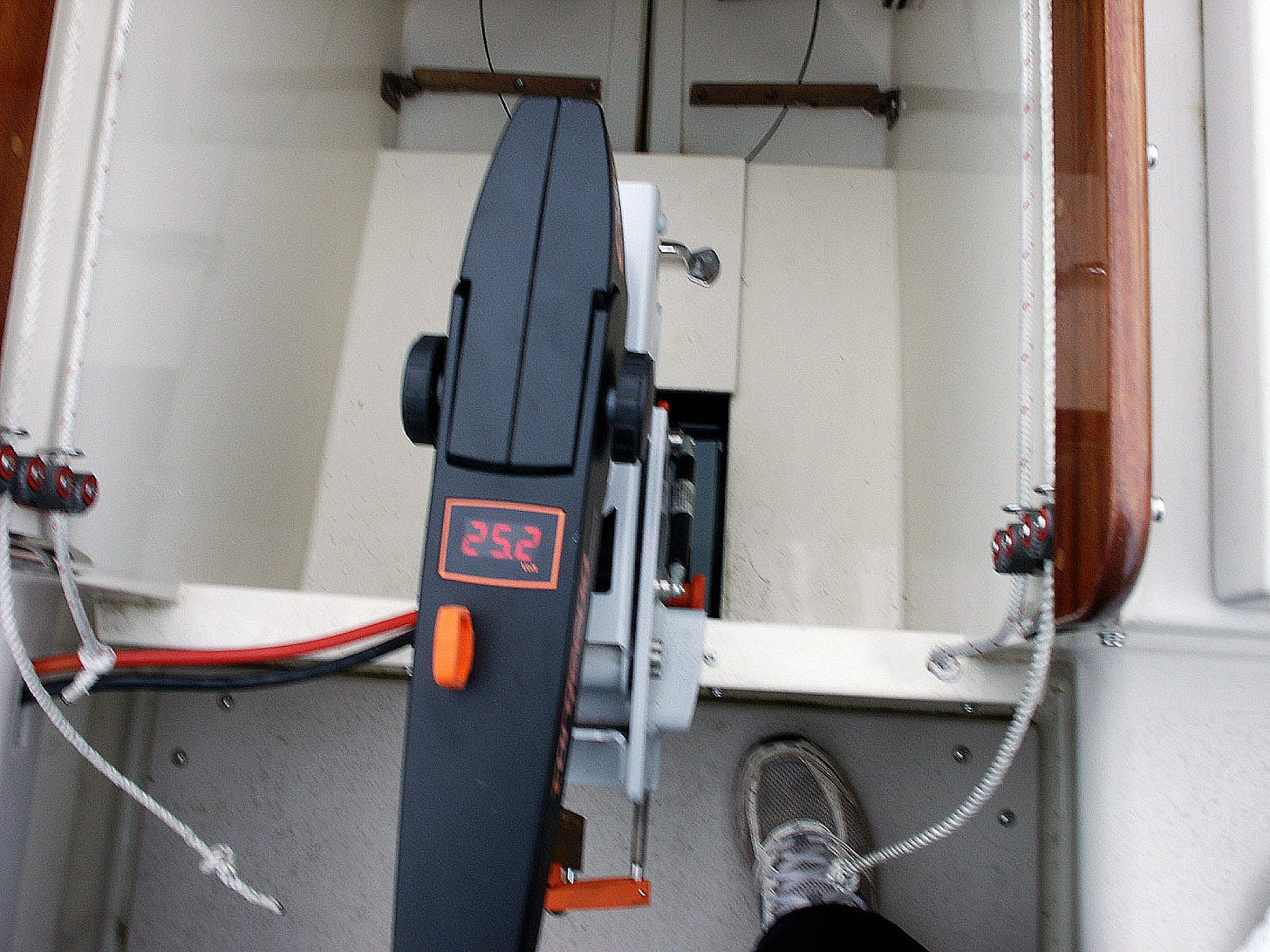Editor’s Note: Until not long ago, our friend Chelcie Liu and his wife Kathy owned a beautiful 24-foot trailerable cruiser, the Townsend Tern, designed and built by Kees Prins of Port Townsend, Washington. After realizing the hull’s original bottom preparation had allowed buildup of marine growth sooner than expected, Chelcie used the opportunity—if you want to call barnacle growth an opportunity—to see how a lightly fouled bottom would affect boat speed, when compared with a smooth-hulled boat with fresh coats of bottom paint. So, here is Chelcie’s report, in photos and captions.


Our first challenge after hauling the boat: How to remove the thin pads left behind after the barnacles had been power-washed away. My wife Kathy, the biologist, suggested we use household vinegar (5% acidity) to help remove the pads…and it worked great. We found the pads could easily be scraped off after wiping a small section of the bottom’s surface a few times with rags soaked in vinegar, and then letting the wiped surface sit for about 20 minutes. An extra vinegar wiping would soften the more stubborn pads. (You can use stronger, more acidic vinegars, but we were happy with the results and felt the milder approach was more environmentally friendly.)
After the bottom was cleaned, we applied our bottom paint of choice: ePaint ZO, a tough, solvent-based product with Zinc Omadine as its active ingredient, thinned with ePaint EP-13 thinner for ease of application. The manufacturer says this paint is a “hybrid finish that incorporates benefits of both hard and ablative paints.” The paint has an unlimited coat-to-launch time, allowing use on trailer boats like ours, so that we could keep the Townsend Tern out of the water during each off-season. (Years later, our final choice for bottom paint would be Coppercoat, a long-lasting epoxy-resin paint that contains a generous amount of pure copper powder.)
The Speed Test
Wanting a before-and-after comparison, we conducted a series of boat-speed tests—with the fouled bottom, and after cleaning and applying fresh bottom paint. Since we used a Torqeedo Cruise 2.0 electric outboard as our auxiliary power, we recorded speed of the boat at various current settings before she was hauled. After the bottom was cleaned and painted, we again recorded her speed at different current settings.
Below, the lower curve (blue diamonds) shows the speeds for the fouled bottom, and the upper curve (red squares and green triangles) shows the speeds for a clean bottom. Speeds for each run were measured in Knots with both a Garmin GPS 72 and a Garmin GPSMAP 76 handheld GPS receiver. Also, the two speeds were recorded for the boat moving in opposite directions for the same current setting. These four speed measurements were averaged to give the speed measurement that was plotted. The current measurements were made with a Xantrex LinkLITE high-precision battery monitor. If there were small changes in the current between the two runs, the plotted point shows the average value.
The data for the blue diamonds and the red squares of the upper curve were obtained with the boat moving in opposite directions parallel to the breakwater along the long fairway in Boat Haven Marina in Port Townsend. As can be seen from the two plots, the boat was moving noticeably faster with a clean bottom. In fact, with a clean bottom and a motor current of only 42 A, we felt she was already moving uncomfortably fast when reversing direction in the marina, at constant current.
Thus, the data for the faster speeds, represented by the green triangles, was obtained with the boat moving parallel to Boat Haven’s long breakwater outside the marina. We also made lower-speed runs so we could see how well the computer generated red square and green triangle curves matched in the region where these two curves overlapped. As can be seen, the two curves were nearly on top of each other in the overlap region.
Looking at the two curves above, we see that the speed increased noticeably for a given motor current. The last time we sailed her before she was hauled, the boat “felt” slower and more sluggish than we remembered. The two performance curves thus confirmed our seat-of-the-pants feeling of how she was performing on that last sail.
When using electric motors for boat propulsion, one of the concerns is range. Because of the shape of the two curves, we see that for a given speed there is a significant increase in range with a clean bottom. For example, we see from the bottom curve that cruising at 4 knots with the dirty bottom required a motor current of about 60 A. However, looking at the top curve, we see that to cruise at 4 knots with a clean bottom only required about 26 A. Thus, the clean bottom required less than half the current giving more than twice the range for cruising at 4 knots.
The shapes of the two curves also show that lowering the cruising speed significantly reduces the current drawn by the motor. In our case, dropping the cruising speed from 4 knots to 3 knots reduced the current from about 60 A to 23 A with a dirty bottom, and from about 26 A to 12 A for a clean bottom. In each case, a 25% reduction in cruising speed reduced the current by more than 50%. While the numbers will vary for different boat/electric motor combinations, the general shape of the curve will be the same. I believe you will find that creating a table and graph for your particular boat/motor combination will be an interesting and informative exercise. •SCA•








A clean bottom cuts the power use in half. Imagine if the propeller had been as foul as the bottom as too often happens on inboard powered auxiliaries.
Sure. How do we do that? Put in your email and I’ll send you contact info?